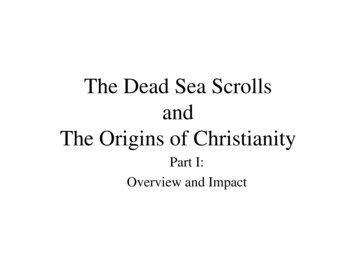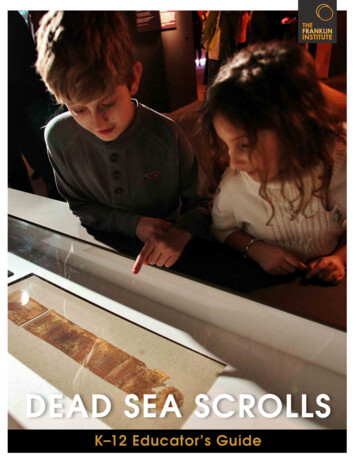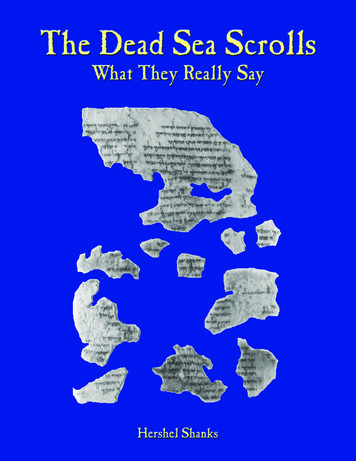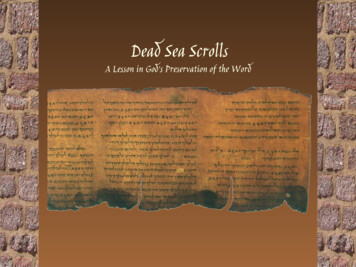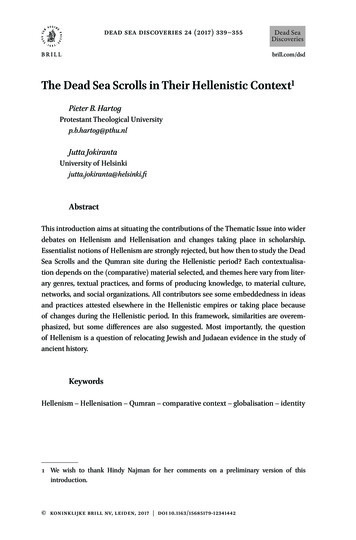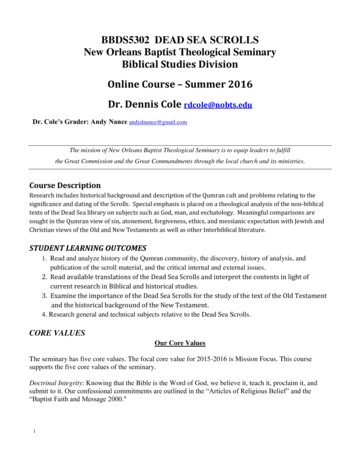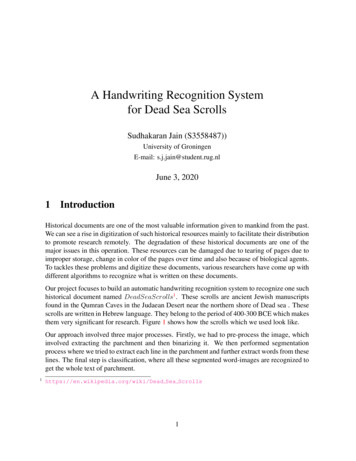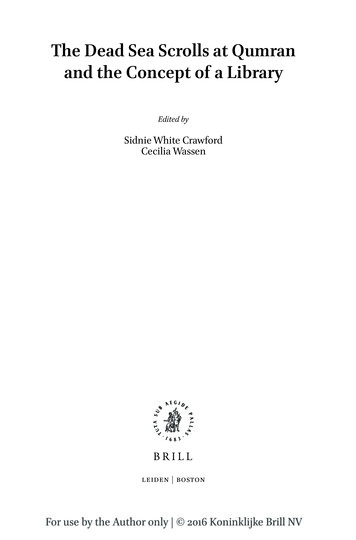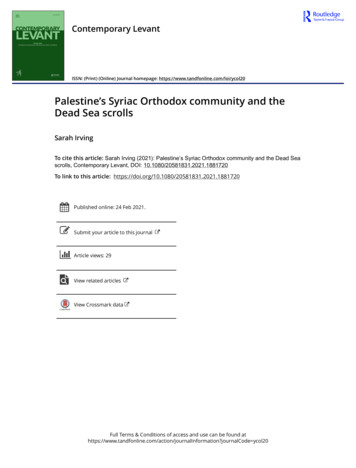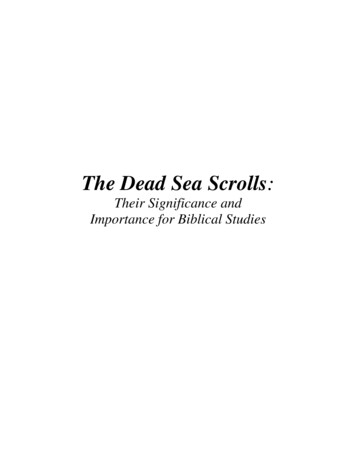
Transcription
The Dead Sea Scrolls:Their Significance andImportance for Biblical Studies
The History of the Discoveryof the Dead Sea ScrollsThe Dead Sea Scrolls were discovered in the spring of 1947 by a youngBedouin shepherd named Muhammad edh-Dhib, on the northwest shore ofthe Dead Sea in a very rugged, mountainous area in a cave (Geza Vermes,The Dead Sea Scrolls: Qumran In Perspective [Cleveland: William Collins& World Publishing Co. Inc., 1978], 9). Since then, one of the mostimportant archaeological finds ever made was announced to the world,which began an intense search for other scrolls, as well as an ongoingdeciphering, analysis, and translation of the ones that were found. In all,eleven caves were discovered containing a treasure trove of manuscripts andfragments that are still being researched today. Over a nine year period(1947-1956), these eleven caves yielded twelve scrolls written on leather andone on copper, as well as thousands of fragments written on papyrus andleather. In all, almost “900 separate manuscripts were found in sometwenty-five thousand pieces, with many no bigger than a postage stamp. Afew scrolls are well preserved, such as the Great Isaiah Scroll . . . and theGreat Psalms Scroll . . . . however, most of the scrolls are very fragmentary”(Martin Abegg, Jr., Peter Flint, & Eugene Ulrich, The Dead Sea ScrollsBible [San Francisco: HarperSanFrancisco, 1999], xiv).With regard to these texts found at Qumran, Geza Vermes describes howthe Qumran scribes took great pains to carefully write and transcribe theirwork in a very delineated manner, and they would use a type of vegetableink that was kept in ink wells. Thus, they were very precise in their writingand use of the materials available to them. The longer works were on scrollson one side only and sewn together; papyrus documents were frequentlyused more than once; and shorter writings such as letters were typicallywritten on small pieces of material, including wood and potsherds (GezaVermes, The Complete Dead Sea Scrolls in English, revised ed. [New York:Penguin Books, 2004], 15). In addition to these eleven caves discovered atQumran, however, there have also been discoveries of manuscripts near theDead Sea in other places, and some of the most significant were at “WadiMurabb’ât (1951-52), Naµal „ever (1951-52 and 1960-61), and Masada(1963-65)” (Abegg, Flint & Ulrich, xiv).We will now take a look at just how the scrolls were discovered andeventually came to the forefront of biblical archaeology and scholarship, but2
first we will get a view of the Dead Sea area where Qumran was located.The following pictures are overviews of the western side of theMediterranean Sea: the first is that of Turkey, Greece, and Italy to the north,the whole of the Middle East to the east and south, and Israel and the DeadSea almost in the direct center; the next three are close ups of Israel and theDead Sea. These pictures will help you see just how geographically centralIsrael is to the world at large.3
4
5
This following picture of the Dead Sea represents why it is called theDead Sea, and that is the saline properties that permeate this body of water.6
However, at this present time, the Dead Sea is in a gradual state of recedingby about three feet per year due to the fact that the water from the JordanRiver is being siphoned off for commercial and public use, and thus, thesesalt deposits are disappearing (Herschel Shanks, “The Dead Sea Scrolls –What They Really Say,” Biblical Archaeology Review v. 33, no. 3[May/June 2007]: 8. Online: http://deadseascrolls.bib-arch.org).This first of the next two pictures is a closer view of Qumran on the coastof the Dead Sea, and the next one actually shows a portion of Dead Sea7
coast line with some vegetation in the foreground, and in the background arethe limestone cliffs of the Dead Sea, which go directly down to the water’sedge. This part of the Dead Sea coastline, which is in front of Qumran andjuts out into the sea, can be seen in the previous overview (Ibid., 9).8
The following picture is that of the caves that punctuate these cliffs alongthe shore of the Dead Sea, and it was from one of the caves pictured here in9
these sheer, limestone cliffs that the first of the Dead Sea Scrolls was foundby the Bedouin shepherd, Muhammad edh-Dhib, in the spring of 1947(Ibid.).Between the coastal plain and the sheer, limestone cliffs punctuated withcaves, lies a much softer rock, upon which Qumran was built. The10
following is a picture of the Qumran ruins as they are today. Whatcontributed to that softer condition of the rock is the fact that it is located ina wadi, or valley, through which the run off of winter rains comes downfrom the cliffs to the Dead Sea (Ibid., 13).This next picture is a close-up of the rock formation just behind thepresent day ruins of Qumran, and as you can see, this formation of rocks juts11
out in bulges, and in these bulging rock formations are man made caves thatcontained thousands of manuscript fragments (Ibid.).The following is a picture of this same rock formation in the spring of theyear, and Cave 4 is one of the holes at the top (Ibid., 13). This Cave12
contained over 500 different scroll manuscripts, including fragment, 4Q246.This fragment contains phrases that are central to the New Testamentpresentation of Jesus: Son of God, Most High and Son of the Most High. Wewill examine this fragment in greater detail later, but suffice it to say that itrepresents the Jewish heritage out of which Christianity emerged, and itscopy date is within 100 years of Jesus’ birth (Robert Eisenman & MichaelWise, The Dead Sea Scrolls Uncovered [New York: Barnes & Noble Books,1994], 68-71).13
This is a picture of someone actually going downinto Cave 4 through a hole at the top of the cave(Ibid., 13).14
Here is a picture inside of Cave 4, and notice theholes in the walls at various heights (Ibid., 14).As was mentioned earlier, there were over 500 manuscript fragmentsfound in Cave 4, and there was no whole, undamaged scroll among them –everything was in fragments. I pointed out the holes in the walls to you,because it is thought that perhaps these were the fittings for storage shelveson which the scrolls were placed. If that is the case, the theory holds that at15
some point the shelves began to break, perhaps due to earthquakes, orsimply through decay over time. The result being that the scrolls fell to theground where they were covered with rock debris and bat feces, and theywere further damaged by various rodents chewing on them. Thus, by the20th century, they were in fragments. The following picture is that of Cave4 fragments, and you can see how these fragmentscame to the researchers in small boxes of manyfragments (Ibid.)16
After the fragments were sorted out and cleaned up, theywere placed under a protective glass and took on theappearance of a puzzle, with only 10 % of its necessarypieces at hand (Ibid.)As was stated at the beginning of our presentation, in the spring of 1947,a young Bedouin shepherd named Muhammad edh-Dhib was looking for alost sheep among some caves on the rugged northwest shore of the DeadSea. The story goes that he threw a rock into a cave in hopes of scaring asheep out if it if he was hiding there. However, what happened is thatinstead of hearing or seeing a sheep run out of the cave, he heard a cracking17
sound of what seemed to him the sound of pottery being broken. Uponentering the cave, he found old pottery jars containing ancient scrolls. Thefollowing is a picture of edh-Dhib himself (on the right), along with anotherBedouin, who together, “are said to have discovered the first seven intactscrolls from what has become known as Cave 1” (Ibid., 10).There were a large number of leather fragments recovered from this firstcave they discovered, representing well over fifty separate and specifictopics and emphases, but the major items found in this first cave were: anincomplete Isaiah manuscript; a scroll of Hymns; the War Rule, which is adescription of the Sons of Light against the Sons of Darkness; the complete18
Isaiah scroll; the Commentary of Habakkuk; the Community Rule; and theGenesis Apocryphon.After the initial discovery, the scrolls eventually emerged in the hands ofa Bethlehem antiquities dealer named Kando, who became the “middlemanfor the Bedouin” (Ibid.). Below is his picture.On November 28, 1947, the day before the UN adopted the PartitionPlan, whereby the Palestinian territory was divided into two sections, aJewish state (55 % of the land) and an Arab state (45% of the land), EleazerLipa Sukenik, a professor of archaeology at Hebrew University inJerusalem, went to Bethlehem to acquire three of the major scrolls found in19
Cave 1, including the incomplete Isaiah scroll. The acquisition wascompleted on November 29, and upon his return to Jerusalem that very day,the streets were crowded with people singing and dancing over the fact thatthe UN had just voted by a 2/3 majority for a Jewish republic to be createdfor the first time in 2000 years! Professor Sukenikwas overwhelmed by what he saw and heard, and it was tohim “almost messianic: to recover a 2,000-year-old scroll,from the time the Jews last had their own state, on the sameday that a Jewish state was again being created was amoving spiritual experience for Sukenik” (Ibid., 11).Below is his picture.The four other major scrolls of Cave 1, including the complete IsaiahScroll, were acquired by the Metropolitan Samuel of the Syrian ChristianChurch in Jerusalem. He tried to sell them in Jerusalem, but nobody wouldbuy them, so he came to the United States in hopes of finding a buyer. Theywere put on display in the Library of Congress, but still there were no20
buyers, so he in turn put an add in The Wall Street Journal advertising thescrolls. The following are pictures of the Metropolitan, as well as the add heplaced in The Wall Street Journal.Professor Sukenik’s son, archaeologist Yigael Yadin, was in the UnitedStates at the time, and he saw the ad in The Wall Street Journal. He tried topurchase them covertly for Israel because he was concerned that if theMetropolitan Samuel knew that he was attempting this on behalf of Israel,the Metropolitan would not sell them to him. Thus, Yadin employed some21
covers and established a price of 250,00 for four, intact Dead Sea Scrolls,which, once again, included the complete Isaiah Scroll. That is what mightbe called a ‘steal’ in both today’s economy, as well as back then for such apriceless source of biblical and historical artifacts (Ibid., 12).This is a picture of Yadin (bald) and anotherscholar attempting to separate pieces of the scrolls.It is thought that the Metropolitan probably knew he was selling to Israelbecause he did not actually have title to these documents since Jordan, notIsrael, had jurisdiction at the time over Qumran, and Jordan attempted toinsist upon its title to the Scrolls. Israel, on the other hand, was notconcerned with who had the bonafide title, but rather with acquiring the22
documents, and that is what they did. Consequently, with the purchase ofthese four scrolls, Israel now had all seven of the major scrolls from Cave 1,and a special museum was built to house them called, the Shrine of theBook. The following is a picture of the Shrine.The white dome represents the lid on the scrolljars, and the black slab and white dome representthe contrast between the Sons of Light and the Sonsof Darkness in the War Scroll (Ibid., 12).The following picture is that of the complete Isaiah Scroll of Cave 1 thatis now housed in the Shrine of the Book. It is opened to 40:3: “The voice ofone crying in the wilderness: ‘Prepare the way of the LORD; Make straightin the desert A highway for our God.’” This passage is quoted in all threesynoptic Gospels, and it is John the Baptist heralding the coming of the23
Messiah and calling on the people to “repent, for the kingdom of heaven is athand. For this is the one referred to by Isaiah the prophet, saying, ‘The voiceof one crying in the wilderness, 'Make ready the way of the Lord, Make Hispaths straight’” (Matthew 3:1-12; Mark 1:1-8; Luke 3:1-14)!24
The Origin of theQumran CommunityIn order to understand the beginnings of the Qumran Community, it isnecessary to go back to the fall of Jerusalem in 587 BC, which in turn led tothe Babylonian Captivity. When the Temple was destroyed in 587 byNebuchadnezzar and the majority of its inhabitants were moved to Babylon(some fleeing to Egypt, taking Jeremiah, and some of the poorest remainingin Judea), Nebuchadnezzar also had some of the leading civil, military, andpriestly leaders executed in Riblah (2 Kgs 25:18-21; Jer 52:24-27). Thus,without a Temple and active priesthood, how could the people carry on theirworship, ministry, and service to the Lord? The answer, many believe,came with the establishment of the synagogue during this period of theBabylonian Captivity.Ezekiel’s ministry was one that took place entirely in Babylon (from 592BC onward – Ezek 1:1-3), and we see some references to the Jewish eldersand people in captivity coming and meeting with him in his home forinstruction (Ezek 8:1; 14:1-5; 33:30-33), which could objectively be viewedas the incipient stage of the synagogue form of worship and teaching. Thepoint being is that those who were truly believers in and followers ofYahweh would continue to worship and serve Him wherever they might be.And in fact, in two of the passages in Ezekiel that I just referred to (Ezek14:1-5 & 33:30-33), we find Ezekiel rebuking the people and calling themback to a true and genuine commitment to the Lord that clearly involves aseparation from self-destructive, worldly mindsets and actions, to an inwardseparation unto the Lord that would reflect in their lifestyles.After the Persian conquest by Cyrus of Babylon in 539, the followingyear he issued the edict of restoration for the Jews to return to Palestine inorder to rebuild the Temple. This of course would entail a reestablishmentof an active and functioning priesthood, including the office of High Priest.There was great excitement, therefore, as the returning refugees began therebuilding of the Temple. However, their enthusiasm was soon dampenedby opposition from the current inhabitants of Israel, which included theSamaritans and others who had not been taken into exile, and who haddeviated from the orthodox beliefs of the returning Jews. Their attempt torebuild the Temple was shut down after the foundation was laid in 535, andit remained shut down until the second year of Darius I in 520 BC. Nowonce again, the Jews needed times and places where they could worship and25
receive teaching during those 15 years, and the synagogue was the obviousplace.In 521, Darius I came to the throne of Persia, and at that same time inJudah, God raised up two prophets, Haggai and Zechariah, and through thesetwo men, God began to inspire the Jews once again to begin rebuilding theTemple:When the prophets, Haggai the prophet and Zechariah the son of Iddo,prophesied to the Jews who were in Judah and Jerusalem, in the nameof the God of Israel, who was over them, then Zerubbabel the son ofShealtiel and Jeshua the son of Jozadak arose and began to rebuild thehouse of God which is in Jerusalem; and the prophets of God werewith them supporting them. (Ezra 5:1-2)Thus, the rebuilding actually began in 519 BC, in Darius’ second year ofrule (Ez. 4:24). However, there was new opposition from a man namedTattenai, who was the provincial governor, and he sent a letter to Dariusreporting about the Temple’s rebuilding project as a result of the ministriesof Haggai and Zechariah. Darius in turn issued a decree to find the edict ofCyrus concerning the rebuilding of the Temple, and it was found, and he inturn commanded that Tattenai help the Jews in every way to finish therebuilding project as quickly as possible:Then Tattenai, the governor of the province beyond the River, Shetharbozenai, and their colleagues carried out the decree with all diligence, justas King Darius had sent. 14 And the elders of the Jews were successful inbuilding through the prophesying of Haggai the prophet and Zechariah theson of Iddo. And they finished building according to the command of theGod of Israel and the decree of Cyrus, Darius, and Artaxerxes king ofPersia. 15 And this temple was completed on the third day of the monthAdar; it was the sixth year of the reign of King Darius. (Ezra 6:13-15)Thus, the Temple was completed on approximately March 15, 515 BC. Wewill now skip from the completion of the Temple in 515 BC, to Ezra’s trip toJerusalem during the reign of King Artaxerxes of Persia (464-423 BC).Ezra was of the priestly line, descended from Aaron:This Ezra went up from Babylon, and he was a scribe skilled in the law ofMoses, which the LORD God of Israel had given; and the king grantedhim all he requested because the hand of the LORD his God was uponhim. 7 And some of the sons of Israel and some of the priests, the Levites,the singers, the gatekeepers, and the temple servants went up to Jerusalemin the seventh year of King Artaxerxes. 8 And he came to Jerusalem in the26
fifth month, which was in the seventh year of the king. 9 For on the first ofthe first month he began to go up from Babylon; and on the first of thefifth month he came to Jerusalem, because the good hand of his God wasupon him. 10 For Ezra had set his heart to study the law of the LORD, andto practice it, and to teach His statutes and ordinances in Israel. (Ezra 7:610)The actual time for the trip went from March 27 – July 24, 457. Artaxerxessent a letter with Ezra with the following directions: anyone from Israelcould return with Ezra; Ezra was given money to purchase whatever heneeded in the way of sacrifices once he arrived; the servants of Yahwehwere not to be taxed; and whoever did not follow the law of God and the lawof the King would be subject to the severest punishment.Once Ezra and his entourage arrived, everything was distributed in anorderly fashion for the purchase of the sacrifices, as well as whatever elsemight be needed for the use of the ministry in the Temple, and the edicts ofthe King were delivered:The exiles who had come from the captivity offered burnt offerings to theGod of Israel: 12 bulls for all Israel, 96 rams, 77 lambs, 12 male goats fora sin offering, all as a burnt offering to the LORD. 36 Then they deliveredthe king's edicts to the king's satraps, and to the governors in the provincesbeyond the River, and they supported the people and the house of God.(Ezra 8:35-36)The actual date for the time of sacrifice appears to be July 28, 457.However, after all of this had taken place, Ezra was approached by theleaders of the people, and they told him some very disturbing things that haddeveloped – mixed marriages with pagans was rampant, which in turn wouldresult in a compromise of believing, following, and living for the Lord,bringing on the people’s self-destruction for themselves, as well as for theirprogeny:Now when these things had been completed, the princes approached me,saying, "The people of Israel and the priests and the Levites have notseparated themselves from the peoples of the lands, according to theirabominations, those of the Canaanites, the Hittites, the Perizzites, theJebusites, the Ammonites, the Moabites, the Egyptians, and the Amorites.2 "For they have taken some of their daughters as wives for themselvesand for their sons, so that the holy race has intermingled with the peoplesof the lands; indeed, the hands of the princes and the rulers have beenforemost in this unfaithfulness.“ (Ezra 9:1-2)27
This in turn brought on some intense reforms dictated by Ezra - theseparation of the men from their foreign wives and their pagan influence,and their return in faithful obedience to Jehovah God. The date for this edictand its implementation appears to be December 11, 457 (Ezra 10:9). As youread this section in Ezra, you come away with a sense of the profoundcommitment Ezra had to the Lord and the Law given to Moses – hisjudgment and actions are very hard to see and understand in our culturetoday, but this is what he had the people to do in order to separatethemselves unto the Lord in both their heart and actions.The ministries of Ezra and Nehemiah overlapped. Ezra was in Judahfrom July 24, 457 BC until late 444 BC, less than one year after Nehemiaharrived from Artaxerxes’ service in 445. Nehemiah rebuilt the wall ofJerusalem in 52 days, from July 18 – September 8, 444 BC. It wasapparently after the wall was rebuilt that Nehemiah 8:1-3 occurred:And all the people gathered as one man at the square which was in front ofthe Water Gate, and they asked Ezra the scribe to bring the book of thelaw of Moses which the LORD had given to Israel. 2 Then Ezra the priestbrought the law before the assembly of men, women, and all who couldlisten with understanding, on the first day of the seventh month. 3 And heread from it before the square which was in front of the Water Gate fromearly morning until midday, in the presence of men and women, those whocould understand; and all the people were attentive to the book of the law.(Nehemiah 8:1-3)Right after this, we read: “Then Nehemiah, who was the governor, and Ezrathe priest and scribe, and the Levites who taught the people said to all thepeople, ‘This day is holy to the LORD your God; do not mourn or weep.’For all the people were weeping when they heard the words of the law” (Neh8:9). According to 8:2, this address was “on the first day of the seventhmonth,” in the year 444, which would make that September 23, 444. Thus,approximately 15 days after the wall was completed, if these calculations arecorrect, Ezra read the entire “book of the law of Moses.”Once again, if these dates and times are figured correctly, this is 15 yearsafter Ezra had addressed the people concerning their mixed marriages, andnow he gives his final address – reading the entire “book of the law ofMoses.” The people repented and joined in a new covenant with the Lord:Now the rest of the people, the priests, the Levites, the gatekeepers, thesingers, the temple servants, and all those who had separated themselvesfrom the peoples of the lands to the law of God, their wives, their sons andtheir daughters, all those who had knowledge and understanding, 29 are28
joining with their kinsmen, their nobles, and are taking on themselves acurse and an oath to walk in God's law, which was given through Moses,God's servant, and to keep and to observe all the commandments of Godour Lord, and His ordinances and His statutes; 30 and that we will not giveour daughters to the peoples of the land or take their daughters for oursons. 31 As for the peoples of the land who bring wares or any grain onthe sabbath day to sell, we will not buy from them on the sabbath or a holyday; and we will forego the crops the seventh year and the exaction ofevery debt. 32 We also placed ourselves under obligation to contributeyearly one third of a shekel for the service of the house of our God: 33 forthe showbread, for the continual grain offering, for the continual burntoffering, the sabbaths, the new moon, for the appointed times, for the holythings and for the sin offerings to make atonement for Israel, and all thework of the house of our God. 34 Likewise we cast lots for the supply ofwood among the priests, the Levites, and the people in order that theymight bring it to the house of our God, according to our fathers'households, at fixed times annually, to burn on the altar of the LORD ourGod as it is written in the law; 35 and in order that they might bring thefirst fruits of our ground and the first fruits of all the fruit of every tree tothe house of the LORD annually, 36 and bring to the house of our God thefirst-born of our sons and of our cattle, and the first-born of our herds andour flocks as it is written in the law, for the priests who are ministering inthe house of our God. 37 We will also bring the first of our dough, ourcontributions, the fruit of every tree, the new wine and the oil to the priestsat the chambers of the house of our God, and the tithe of our ground to theLevites, for the Levites are they who receive the tithes in all the ruraltowns. 38 And the priest, the son of Aaron, shall be with the Levites whenthe Levites receive tithes, and the Levites shall bring up the tenth of thetithes to the house of our God, to the chambers of the storehouse. 39 Forthe sons of Israel and the sons of Levi shall bring the contribution of thegrain, the new wine and the oil, to the chambers; there are the utensils ofthe sanctuary, the priests who are ministering, the gatekeepers, and thesingers. Thus we will not neglect the house of our God. (Neh 10:28-39)Soon after this covenant was ratified with the people, Ezra apparentlydeparts and returns to Susa, the Persian capitol, in late 444 BC. In 432 BC,Nehemiah returns to Susa for a period of time (Neh. 13:6), and while he isgone, the character of the people begins to slide as a result of spiritual andmoral compromise: Eliashib, the high priest, had allowed Tobiah, theAmmonite, to have his own special room within the Temple compound; thepeople had not been bringing in their tithes, and thus, the Levites were notbeing recompensed for their service to the Lord, thereby forcing them toreturn to their own fields in order to support their families and leaving offtheir ministerial work; the people had returned to working on the Sabbath;and lastly, the people had once again returned to marrying pagans and29
bringing in a godless and spiritually compromising influence into theirculture. Nehemiah rebuked them for their compromising lifestyles, and heset about to restore them to the level of spiritual separation and inwardholiness where he felt they should be in their relationship with Jehovah God(Neh 13:4-31).With the Community at Qumran, we see some striking similaritiesbetween them and the Judeans of the mid 5th century. First of all, theEssenes are considered to be the inhabitants of Qumran from the mid 2ndcentury BC to 68 AD. Josephus makes an extensive reference to them asbeing one of three major sects of Judaism at the time of Christ:For there are three philosophical sects among the Jews. The followers ofthe first of whom are the Pharisees; of the second the Sadducces; and thethird sect, who pretends to a severer discipline, and called Essenes. Theselast are Jews by birth, and seem to have a greater affection for one anotherthan the other sects have. (JW 2.8.2 # 119)There has been some debate over whether or not the Essenes were the actualinhabitants of Qumran, but the overwhelming and convincing evidencesupports the view that they were.Secondly, the Essenes lived a very strict, moral lifestyle, akin in someways to that of the Judeans under Ezra and Nehemiah, but in some areas,even more strict. Again, Josephus points out some of their beliefs andpractices:These Essenes reject pleasures as an evil, but esteem continence, and theconquest over our passions, to be virtue. They neglect wedlock, but chooseout other persons’ children, while they are pliable, and fit for learning; andesteem them to be of their kindred, and form them according to their ownmanners. They do not absolutely deny the fitness of marriage, and thesuccession of mankind thereby continued; but they guard against thelascivious behavior of women, and are persuaded that none of thempreserve their fidelity to one man. . . . They also avoid spitting the themidst of them, or on the right side. Moreover, they are stricter than anyother of the Jews in resting from their labors on the seventh day; for theynot only get their food ready the day before, that they may not be obligedto kindle a fire on that day, but they will not remove any vessel out of itsplace, nor go to stool thereon. (JW 2.8.2 #120-121, 147)Thirdly, in Ezra and Nehemiah, we saw a deterioration of spiritualleadership in the Temple worship, and in particular with the High Priest,Eliashib (Neh 13:4-9, 28-29). This is the same type of thing that led to theMaccabean revolt and also constituted some of the reasons for the30
establishment of Qumran. When Antiochus Epiphanes assumed theSeleucid throne in 175 BC (after Alexander the Great died on June 10, 323BC, his kingdom was ultimately divided up between his generals –Antigonus I, Cassander, Lysimcahus, Ptolemy I, & Seleucus I – withPtolemy and Seleucus being the most significant as far as their impact onwestern civilization and biblical history is concerned, Ptolemy receivingEgypt, and Seleucus claiming Syria), he initially kept Onias III (195-175),the current High Priest, in Jerusalem. But later, he removed him from theHigh Priesthood and appointed his brother, Jason, in his place because Jasonpaid Epiphanes more money for the position. Three years later, in 172,Epiphanes removed Jason and replaced him with Menelaus (172-162), of thepriestly tribe of Bilga, whose brother, Simon, had been an opponent of OniasIII. All of these actions were viewed by the Jews as completely out of lineas far as their law was concerned – the unlawful removal of a sitting HighPriest who was well and able to serve and replacing him with his brother;then, to remove the brother and replace him with someone from a priestlyline other than the Zadokite line, who had no right to serve, was anathema inthe eyes of the committed Jews (Urriel Rappaport, “Maccabean Revolt” TheAnchor Bible Dictionary [New York: Doubleday, 1996]).The second area that was of great concern to those Jews committed toJewish law as the grid for their lives and culture was the increasedHellenization of their culture as a result of this unlawful investiture ofspiritual authority by Antiochus Epiphanes, and that was especially true withboth Jason and Menelaus:But after the death of Seleucus, when Antiochus
of the Dead Sea Scrolls The Dead Sea Scrolls were discovered in the spring of 1947 by a young Bedouin shepherd named Muhammad edh-Dhib, on the northwest shore of the Dead Sea in a very rugged, mountainous area in a cave (Geza Vermes, The Dead Sea Scrolls: Qumran In Perspective [Cleveland: William Collins & World Publishing Co. Inc., 1978], 9).
